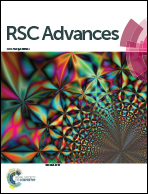Silica-aerogel-powders “jammed” polyimide aerogels with excellent hydrophobicity and conversion to ultra-light polyimide aerogel†
Abstract
Silica aerogel powders (SAp) are the scrap materials derived from the industrial production and use of silica-aerogel products and become the challenges to be disposed. In this paper, SAp play a role as the shrinkage inhibiter to fabricate the SAp “jammed” polyimide gels. Herein, the “jammed” effect means that the polyimide backbones have been “stretched up” by the micron-scale SAp. Namely, the strong chains-packing effect, which is always taking placing during the gelation process and results in a high shrinkage of the polyimide backbones, has been effectively prevented by a simple physical mixture of SAp. This “jammed” effect greatly reduces the shrinkage as low as 7.5%. Meanwhile, SAp are treated as the pore formers to make a conversion to polyimide aerogel with ultra-low density of about 0.02 g cm−3. In addition, incorporation of SAp also dramatically enhances the hydrophobicity (water contact angle up to 152°). Overall, SAp “jammed” polyimide aerogels have low thermal conductivity (0.028–0.031 W m−1 K−1), high mechanical strength, and high thermal stability. This combination of properties makes them more applicable as thermal insulators in harsh environments. Certainly, recycling of the scraped SAp by simple physical mixture with organic PI is also an advocated way for energy conservation.


 Please wait while we load your content...
Please wait while we load your content...